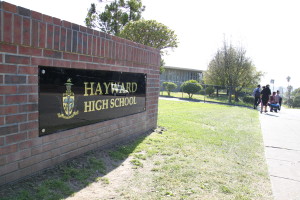
programs at HUSD schools such as Hayward High.
June 5 ballots are expected to contain Measure G, a parcel tax of $58 on homeowners living in the Hayward Unified School District (HUSD), set in hopes to generate significant funding to maintain basic academic programs.
Parcel taxes, or non-deductible property taxes, are imposed by the local government and would be collected by an independent “tax collector.”
Measure G was placed on the ballot by the Teacher’s Union and funded in the polls by the HUSD school district.
The parcel tax requires two-thirds votes from Alameda County, and would be aimed solely at benefitting the surrounding unified schools in the area. It will also assist in “enhancing library services, alongside technology and college preparation programs,” according to the ballot measure submittal form.
Jesus Armas and Doris Rodrigues are the co-chairs of Measure G. Armas explained that the parcel tax would generate an estimated 2 million dollars annually and would be beneficial to “all of our students to help prepare them for college.” He also specified that the measure would “provide a good academic foundation” for Hayward students and would further “help with academic achievements.”
Presumed to “attract and retain teachers,” the Quality Local Schools and Academic Excellence Measure includes provisions ensuring the funds go to schools and not to administrator’s salaries. Moreover, Armas emphasized that the money is generated locally, thus promising that the “funds cannot be taken by the state.”
Due to California’s budge crisis, however, $7.4 million has been cut from the state school systems. People within the HUSD are expected to pay the parcel tax annually for five years starting on July 1, 2012 if the measure is passed. Additionally, people over the age of 65 can request an exemption.
Republican candidate for State Assembly Luis Reynoso critically stated that Measure G “was poorly planned and not necessary.” He explains that it was “put on [the ballot] at the last minute, is sloppy, and [that] none of the opposition had time to write a statement.”
Furthermore, he mentions that a significant amount of money is being spent to place Measure G on the ballot. Reynoso also made a suggestion that “instead of asking for money, we could save the money” by relocating it from other resources.
Peter Bufete, a 22-year-old Democrat running for City Council of Hayward, stated Measure G will “protect critical necessities for the school district.”
Bufete explains the measure is only for five years, which will help with the “huge struggle for resources,” adding that there are “great administrative resources that are limited.”
Measure G is not the first of its kind on the voting ballot for Alameda County. Measure L, which didn’t pass in 2010, was geared towards Oakland’s Unified School District and was supposed to levy $195 per homeowner for 10 years. Furthermore, the Fremont Unified School District passed Measure K with 70 percent approval, levying $53 per homeowner in 2010, and is trying to extend its dates from 2014 to 2017.
In addition, Measure B will appear on the 2012 ballot with similar speech. It would levy $48 annually in the Peralta Community College District located in Alameda County and affects several community colleges in that district including College of Alameda, Laney College, Merritt College and Berkeley City College.











